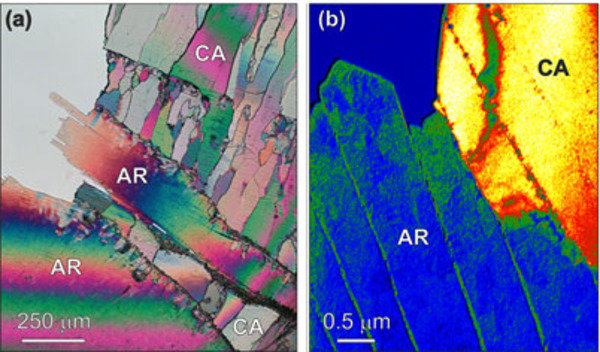
Interfaces and Contacts in Natural Composite Materials
A great variety of biological tissues are produced as natural hybrid materials. Their amazing combination of biominerals with organic compounds arranged in complex architectures leads to materials with excellent properties (physical and mechanical) that are far superior to modern, technologically advanced, man-made materials [1, 2].
Different types of molluscs build shells of diverse shapes and sizes, but surprisingly the mineral involved is in most cases calcium carbonate (CaCO3) mainly in the form of calcite and/or aragonite. When both polymorphs co-exist within the shell, they are always spatially distinct, in different parts of the shell [3, 4]. The primary function of the shell is to provide protection for the soft bodies of the animals [5].
For our study, abalone shell (Haliotis rufescens) was used. A typical abalone shell consists of an outer prismatic calcite layer and an inner nacreous aragonite layer. The nacre (mother-of-pearl) consists of polygonal aragonite platelets that are separated by layers of a protein-polysaccharide organic matrix [3]. The aim of our work was the investigation of inorganic-inorganic and organic-inorganic interfaces and contacts in abalone shell using a combination of bright field (BF) and annular dark field scanning transmission electron microscopy (STEM) imaging in conjunction with electron energy-loss spectroscopy. A BF-STEM image of a regular contact region between prismatic calcite (CA) and nacreous aragonite (AR) is shown above, left.
An ability to self-heal is quite a common phenomenon in nature, allowing biological structures to repair themselves after an injury [5]. A self-healed region of calcite – aragonite contact (above, right) was investigated in detail. ELNES spectra were acquired from different positions in the vicinity of the contact. These showed clear differences between the spectra recorded in CA and AR, indicating, for example, different coordination environments of calcium in the different mineral forms.
There is a growing interest in composite inorganic-organic materials due to their outstanding microstructure-controlled properties. Therefore, natural composite materials have been an inspiration and a model example for hybrid functional man-made materials.
[1] UGK Wegst and MF Ashby, Philos Mag 84 (2004), 2167-2181.
[2] AP Jackson and JFV Vincent, J Mater Sci 25 (1990), 3173-3178.
[3] S Mann in "Biomineralization" (Oxford University Press, New York)
[4] HA Lowenstam and S Weiner in "On biomineralization" (Oxford University Press, New York)
[5] MA Meyers et al, Prog Mater Sci 53 (2008), 1-206.